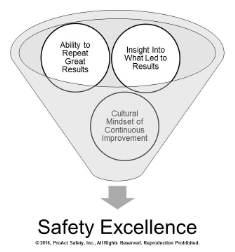Rethinking Safety Excellence
Great performers are able to demonstrate the ability to win over and over again.
It is now illegal to use injury rates and results to measure safety. Finding ourselves in this new reality, how do we measure the effectiveness of our efforts? How do we measure improvement? How do we determine whether we are on the path to excellence, have reached a plateau, or are off course and going in the wrong direction? This extreme hypothetical scenario is exactly what is needed to challenge the status quo when it comes to how safety excellence is thought of today.
What we have defined as great in safety has been largely and historically determined by incident and injury rates and only surface-level and subjective measurements about the organization and its culture. All progress begins by thinking differently. It’s time we rethink what constitutes excellence in safety. As we complete another Olympics, the events provide a great analogy for how to do just that.
Larger participating countries tend to chase the medal count. Multiple events occur and cannot be broadcasted simultaneously. There is often a time delay between when events occur and when they are available to be watched from the comfort of our homes. Because of these Olympics realities, we often hear who medaled in an event before we watch the performance that contributed to it. When we already know the outcome of the event, when watching the activity, we often say to ourselves, "That's why she received the gold" or "That's why he was only awarded the silver or bronze." We are able to recognize what precise performance yielded the results.
If you had received the gold medal for zero injuries or incidents for the past year, what common performance would you see if you played back the year that contributed to the outcome? What would you see that could be improved upon?
There are three parts to a better definition of safety excellence. (See the figure, Three-Part Definition of Safety Excellence.)

1. The Ability to Achieve and Repeat Great Results. Great incident rates will be a part of defining safety excellence for the foreseeable future. But this is more than a one-time victory; it is also the ability to repeat and sustain these results over long periods of time. Great performers are able to demonstrate the ability to win over and over again.
2. Keen Insight Into What Led to the Results. Leaders must be able to explain why great results were achieved (or not) and must have indicators that forecast, with confidence, future outcomes. It is not enough to experience great outcomes; a leader must know what led to the outcomes so they can be repeated.
3. A Cultural Mindset of Continuous Improvement. Cintas calls this "positive discontent." Shell uses the term "chronic unease." There must exist a mindset that further improvement is always possible and, rather than accepting a best practice, strive for a continuous search for better practices. There will always be new innovative ways to reduce risk exposure and add value to those participating in safety improvement efforts, but only with a culture that is willing to explore those opportunities.
While important and ideal, achieving zero injuries is only a small part of what defines excellence in safety. If there isn’t extreme clarity about what led to the result of zero injuries and a collective, continuous mindset that further improvement will always be possible once great results are reached, excellence is still a distant goal. It is not enough to reach zero injuries. We must know how we achieved this, what led to it, and still know how we can deliver further value. This makes up a better definition of safety excellence. How is it defined within your organization?
This article originally appeared in the October 2016 issue of Occupational Health & Safety.
About the Author
Shawn M. Galloway is the president of ProAct Safety and co-author of several best-selling books. As a consultant, advisor, and keynote speaker, he has helped hundreds of organizations within every major industry to improve safety strategy, culture, leadership, and engagement. He is also the host of the acclaimed weekly podcast series Safety Culture Excellence®. He can be reached at 936-273-8700 or info@ProActSafety.com.